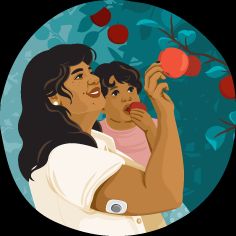A migraine cocktail is a term that’s used to describe a combination of medications that can help you find relief from a migraine attack.
It’s estimated that
Sometimes, in medical settings, migraine symptoms may be treated with a “migraine cocktail.” This isn’t a drink, but rather a combination of specific medications to help relieve migraine symptoms.
Keep reading to learn more about what’s in a migraine cocktail, the possible side effects, and other migraine treatment options.
The exact medications in a migraine cocktail could vary depending on other medical conditions you may have and your previous response to migraine rescue treatments.
Some of the medications that may be included in a migraine cocktail include:
- Triptans: These medications have anti-inflammatory effects and may narrow the blood vessels in your brain, helping to ease pain. An example of a triptan in a migraine cocktail is sumatriptan (Imitrex).
- Antiemetics: These medications can help relieve nausea and vomiting. Examples that could be used in a migraine cocktail include prochlorperazine (Compazine) and metoclopramide (Reglan).
- Ergot alkaloids: Ergot alkaloids work similarly to triptans. Dihydroergotamine is an example of an ergot alkaloid used in a migraine cocktail.
- Nonsteroidal anti-inflammatory drugs (NSAIDs): NSAIDs are a type of pain-relieving medication. One type of NSAID that may be present in a migraine cocktail is ketorolac (Toradol).
- Injectable steroids: These medications help ease pain and inflammation. They may be given to help prevent your migraine from coming back in the next few days.
- Intravenous (IV) fluids: IV fluids help replace any fluids you may have lost and prevent possible side effects from the medications in a migraine cocktail.
- IV magnesium: Magnesium is a natural element that’s often used to prevent migraine attacks.
- IV valproic acid (Depakote): This is a seizure medication that can be used to treat a severe migraine attack.
A migraine cocktail is typically administered in an emergency room or urgent care facility by a nurse or general practitioner, according to the American Migraine Foundation.
A migraine cocktail may be administered:
- if your usual at-home treatment plan isn’t working
- to treat a migraine attack that lasts 3 or more days
The medications in a migraine cocktail are usually given intravenously (via IV). It may take up to 2 hours for the effects of this treatment to start working and to feel symptom relief.
The possible side effects of a migraine cocktail will depend on the specific type of medication you take. Some of the
- Triptans: fatigue, aches and pains, and tightness in areas like the chest, neck, and jaw
- Neuroleptics and antiemetics: muscle tics, muscle tremors, and restlessness
- Ergot alkaloids: sleepiness, stomach upset, nausea, and vomiting
- NSAIDs: stomach upset, diarrhea, and abdominal pain
- Steroids: nausea, dizziness, and trouble sleeping
An over-the-counter (OTC) migraine cocktail is a combination of
- Aspirin, 250 milligrams (mg): This medication is used to reduce pain and inflammation.
- Acetaminophen, 250 mg: This pain reliever works by reducing the number of prostaglandins your body produces.
- Caffeine, 65 mg: This causes vasoconstriction (narrowing of blood vessels).
OTC medications that contain all three ingredients, such as Excedrin Migraine and Excedrin Extra Strength, are known as combination medications. When taken together, each ingredient is more effective at relieving migraine than the individual ingredient alone.
However, it’s important not to take combination medications more than
Instead, consider taking simple analgesics like ibuprofen (Advil, Motrin), naproxen (Aleve), or acetaminophen (Tylenol) alone to treat migraine.
That said, it’s also important not to take simple analgesics for 15 days or more during the month, as this may lead to medication overuse headaches, too.
Generic brands may also have the same combination of ingredients, so be sure to check the product packaging to confirm the active ingredients.
OTC migraine medications that contain aspirin, acetaminophen, and caffeine may
- people who’ve had a prior allergic reaction to any of the three components
- anyone taking other medications that contain acetaminophen
- children under age 12 years, due to the risk of Reye’s syndrome
Some potential side effects of this type of medication include:
- abdominal pain
- nausea
- vomiting
- diarrhea
- dizziness
- trouble sleeping
- medication overuse headache
Before taking any OTC migraine medications, speak with a doctor if you:
- have a very severe migraine attack or head pain that’s different from your typical episode
- are pregnant, breastfeeding, or chestfeeding
- have liver disease, heart disease, or kidney disease
- have a history of conditions like heartburn or ulcers
- have asthma
- are taking any other medications, specifically diuretics, blood-thinning drugs, steroids, or other NSAIDs
Medications for acute migraine aim to help relieve migraine symptoms. These are typically taken as soon as you feel the onset of symptoms. Options
- OTC medications, such as acetaminophen (Tylenol), NSAIDs like ibuprofen (Advil, Motrin), and aspirin (Bayer)
- triptans, such as sumatriptan (Imitrex), rizatriptan (Maxalt), and almotriptan (Axert)
- Ergot alkaloids, such as dihydroergotamine (Migranal) and ergotamine tartrate (Ergomar)
- gepants, such as ubrogepant (Ubrelvy) and rimegepant (Nurtec ODT)
- ditans, such as lasmiditan (Reyvow)
Medications to help prevent a migraine attack from occurring may
- blood pressure medications, such as beta-blockers and calcium channel blockers
- tricyclic antidepressants, such as amitriptyline and venlafaxine
- antiseizure medications, such as valproate and topiramate (Topamax)
- calcitonin gene-related peptide (CGRP) inhibitors, such as erenumab (Aimovig) and fremanezumab (Ajovy)
- botox injections
Some nonpharmaceutical treatments may also help relieve symptoms or prevent migraine onset. Some options may
- biofeedback
- breathing exercises
- meditation
- regular exercise
- acupuncture
- yoga
- cognitive behavioral training (CBT)
- taking supplements, such as vitamin B2, coenzyme Q10, and magnesium
It’s important to note that some herbs, vitamins, and mineral supplements may not be safe for everyone. Be sure to talk with a doctor before trying these remedies.
The three ingredients in an OTC migraine cocktail, or combination medication, include acetaminophen, aspirin, and caffeine.
A migraine cocktail at urgent care may include a combination of medications. First-line treatment may include NSAIDs, triptans, and antiemetics administered intravenously. A doctor may also recommend anti-seizure drugs or magnesium.
The active ingredient in Benadryl, diphenhydramine, is sometimes used as part of a migraine cocktail to help treat extrapyramidal side effects from other treatments. These side effects may include involuntary muscle movements, restlessness, and tremor, among others.
A migraine cocktail is a combination of medications given in a medical setting to treat severe migraine symptoms. The exact medications used in a migraine cocktail can vary, but typically include triptans, NSAIDs, and antiemetics.
A migraine cocktail is also available in OTC medication. OTC products usually contain aspirin, acetaminophen, and caffeine. These components are more effective when they’re used together than when they’re taken alone.
Many different types of medications are routinely used to treat or prevent migraine symptoms. Additionally, some herbs, supplements, and relaxation techniques may help.
It’s important to talk with a doctor about the type of treatment that may work best for you.










